Sidewalk Studio deja vu
INTRODUCTION
Every once in a while by looking back you can see the future. As I was finishing the fourth year of my UP IN ARMS series, I came upon some of the first watercolors I did based on photographs I had taken of people in public places. They intrigued me with their confrontational faces and candid poses–so very unlike the stylized UP IN ARMS paintings in which I showed only the person’s arms and an object he or she was holding. (Most of the UP IN ARMS series can be found at: http://www.scottponemone.com/portfolio/up-in-arms-2/)
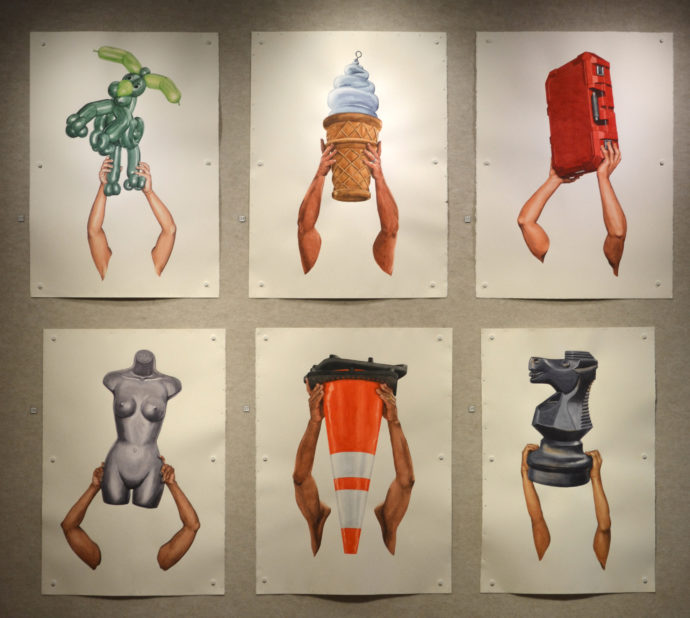
When these six watercolors were arranged for my summer 2017 exhibition at the Harford County Community College, I called this group PLASTIC. (top row, L to R) “KW-Fake II,” 2013; “Soft Cone:” 2015; “Toolbox,” 2015 (bottom row, L to R) “Torso,” 2014; “One for the Road,” 2014; “Knight,” 2014. All are on paper approximately 35” x 25″
The older paintings–from 1983–inspired me to see what would happen if I returned to three-quarter views of people in public places. I started this return-to-the-past effort late last summer. As 2017 ends and now that I’ve completed four of the new painting, I’d like to share what happened and compare the new works to those I did 34 years ago. In some ways they’re the same and in some ways they’re very different.
1983
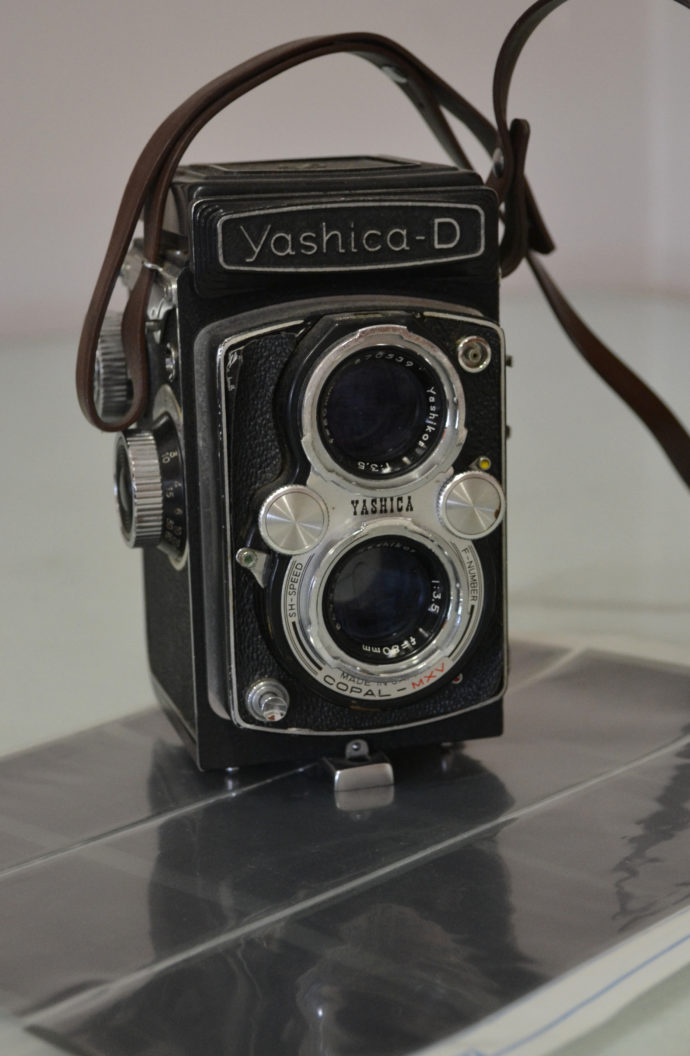
My mode of operation then was to use a c. 1950 twin-lens reflex Yashica-D camera to photograph my subjects. I chose that camera–a gift from my father–for fairness sake. Unlike a 35-mm camera it had no telephoto lens. To create the images I wanted I needed to be about 10-15 feet aways from my subjects, i.e. I wanted to be visible to all, not shooting from a distance. You see I wasn’t asking for permission to photograph folks, yet I wanted to be close enough for someone to object or at least ask me what I was doing. But no one ever did either, although a few folks moved aside thinking they were blocking a view of my intended subject.
One real advance using this camera was that it was less threatening than using a 35-mm camera. With the latter, I would have to cover my face and, I believe, appear threatening. With the Yashica I needed to look both down into the viewer and up at would-be subjects.
My Yashica had a 120 back, meaning it took film with only 12 shots per roll. Such limited capacity encouraged one to be methodical in shot selection. Also the images in the view finder were reversed right and left, making photographing moving subjects somewhat problematic.
No wonder I chose subjects that were barely moving in a public space (where permission wasn’t necessary). My location was in Baltimore’s Inner Harbor outside the National Aquarium, which opened in 1981. In 1983 it was still the prime Inner Harbor attraction with long lines snaking out from the ticket booth. Those folks in the slow moving line on a hot day were my subjects. Not so thrilled to be caught in the summer’s sun, they were my captive audience.
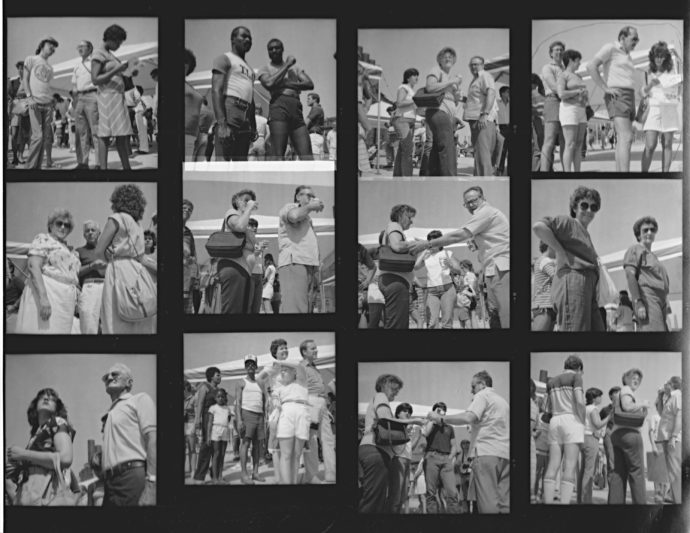
The top second-from-the-left image became the sketch photo for “Tokens.” Scroll down to see the resulting photo and watercolor.
Here’s a contact sheet from that summer. Note that the frames are square. The Yashica created 6×6-mm negatives, yielding great detail. And the choice of black-and-white film wasn’t accidental for two reasons: 1) I could process B&W film and print B&W photos at home and 2) I thought color photos would crimp the creative process. First of all, I admit that I was sensitive about using photography as my sketching medium. So having to transpose a B&W image into a color watercolor would be a worthy and honorable challenge. Furthermore I thought a color photograph was just too much a finished product. Why paint it?
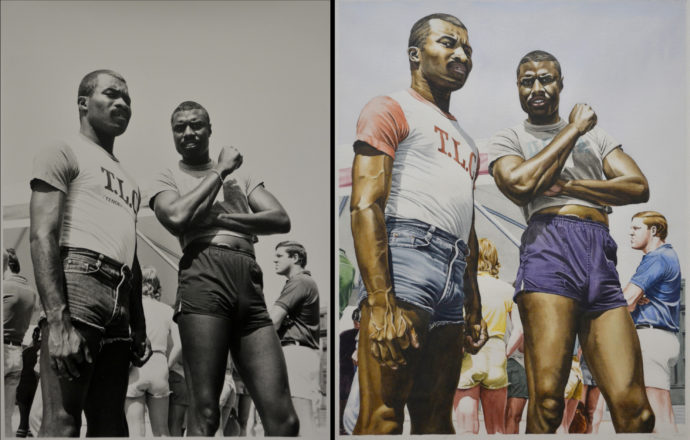
The photo and finished watercolor for “Tokens,” 8 Nov. 1983, image 21 3/4” x 17 1/2″
I did 10 paintings from aquarium line photos. Two of them sold. Here are three more still in my collection.
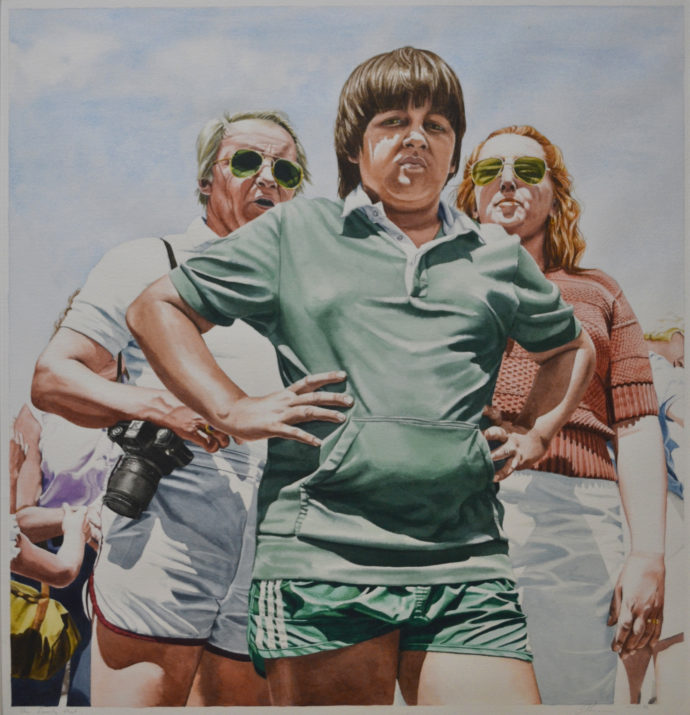
“The Family That,” 11 Oct. 1983, image 21” x 20 3/8″
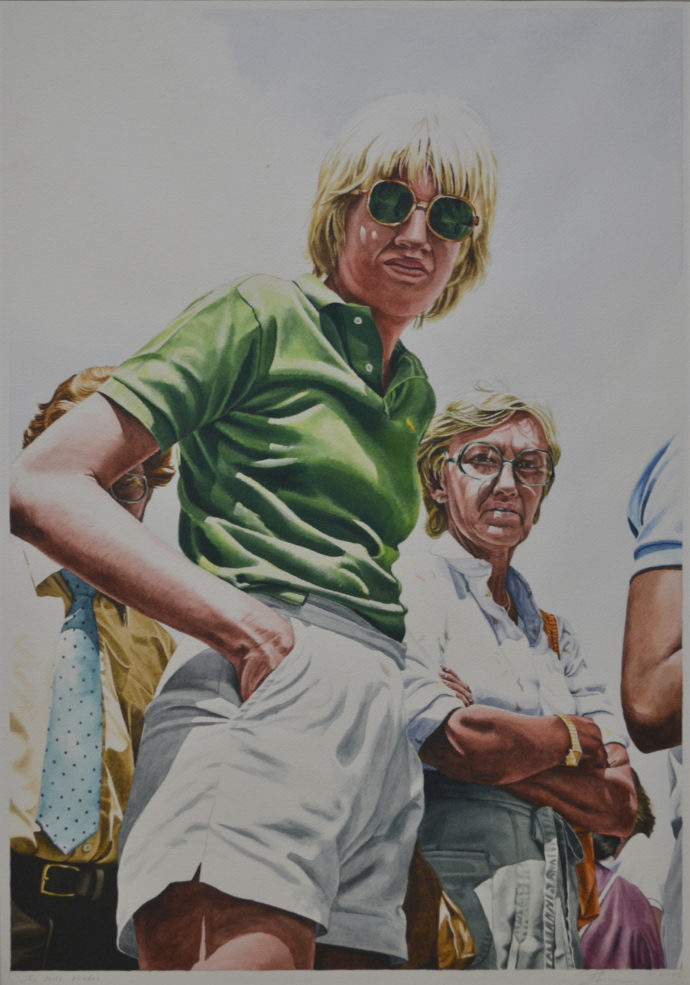
“She Sells Shades,” 21 Nov. 1983, image 21” x 14 3/4″
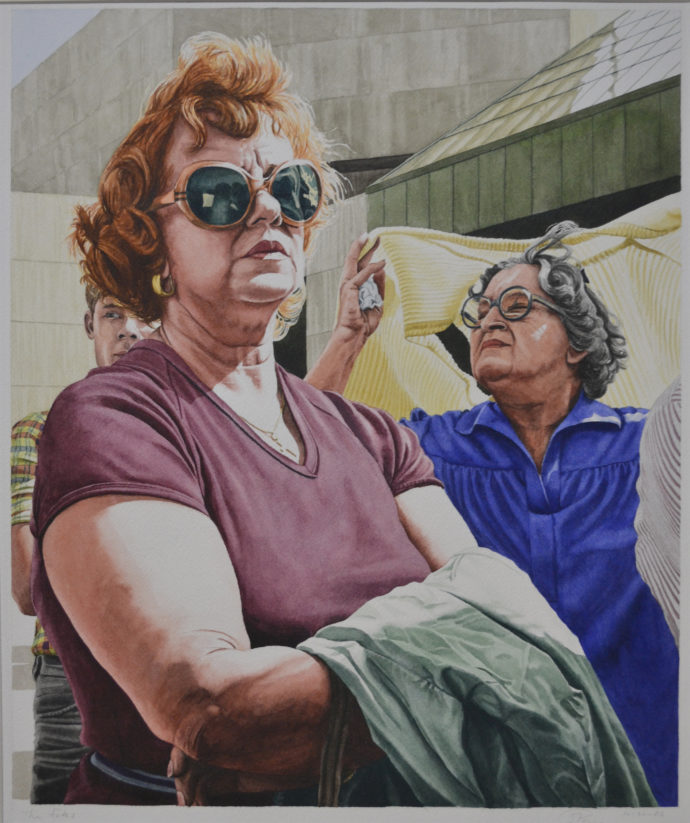
“The Fates,” 30 Dec. 1983, image 16” x 13 1/2″
I marveled at what happened when a stranger, i.e. me, pointed a camera at folks in line without declaring his intentions. It wasn’t immediately apparent who was with whom when I walked along the queue. But as soon as I directed my camera at a particular segment of the line, family and/or friends groupings immediately made themselves known. Look at “The Family That” paintings, above, to see the defensive posture the young man made in front of his parents.
2017
The three biggest changes from 1983 were: 1) 21st-century technology, 2) I introduce myself to my subjects and 3) I have no qualms about using color photos as sketches for watercolors.
Who in 1983 could have imagined an iPhone? Forget even my digital 35-mm Nikon. I used my iPhone to take photos. This had a great feature. Once I photographed folks, they can select an image they can have instantly. Once they chose the frame they liked, they message themselves a copy of the image.
Instead of being mum when I chose a potential subject as I was in 1983, I would introduce myself and as quickly as possible before they move away explain that I would like them to model for paintings. If they express any interest, I show them images in my phone of willing individuals/couples and, once I had completed the first painting in the new series, an image of a completed painting.
The UP IN ARMS series that started in 2013 gave me plenty of practice of asking strangers to model for me. The first people I approached were those who were walking small dogs. “Would you hold your pet love your head so I could photograph you?” I explained I was only going to paint their arms and their pup. Small dogs seemed to enjoy the view. (Oscar, my cat, was not humored by the imposition.) Next I tried the farmers’ market. “How many ears of corn can you raise above your head at one time?” I instantly got a taker.
Somewhere over the years I lost my embarrassment about using color photos as my sketches. I think that happened because I realized that my art began when I approached folks to model, that the interaction between myself–the artist–and them–the subject–was an art event in itself. Perhaps as meaningful as the finished painting.

I began the new series by visiting Baltimore’s Inner Harbor. Here’s a screenshot from my iPhotos library of most of the photos shot on a very warm 7 Oct. 2017. So far three of these images became models for paintings. That’s a pretty high ratio: total frames per selected images. I credit that not so much to any skill on my part. Rather subjects seem instantly to know how they want to appear. For instance the black couple (top left) only needed one pose. Many required two shots: one smiling (that they would message back to themselves) and at my request one unsmiling (as possible image for a painting).
Why unsmiling? I believe smiling photos look like snapshots. Smiles seem to indicate friendliness, but smiles can also act like masks that deflect efforts to get to know someone. Unsmiling individuals seem to declare: “This is whom I am. Who are you?” That’s what I want viewers of the new paintings to confront.
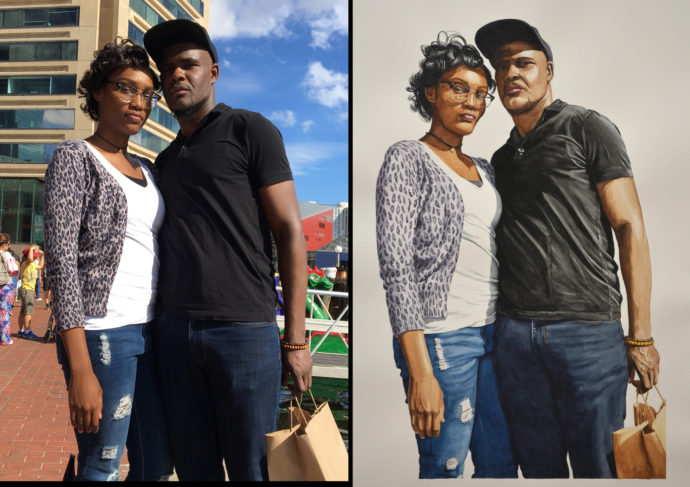
Inner Harbor photo paired with “Untitled (black couple),” watercolor, 21 Oct. 2017, image 32” x 20 1/4″
I would have liked to title this painting by the first names of the individuals. In fact, I sent an image of the painting back to them via the phone number they used to receive a copy of the photo. But I got no response. In fact, no one has gotten back to me. Until someone does, these paintings will remain untitled with a parenthetical label giving generic description of the subjects.

Above are some of the steps in creating “Untitled (black couple).” I paint the flesh tones and hair first. Below focuses on the creation of the pair of faces.

And below is a comparison of paintings featuring black couples: the 1983 painting (left) the 2017 one (right).
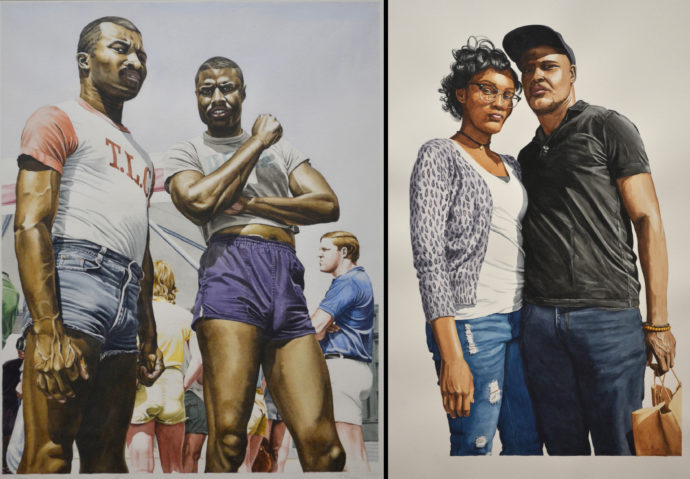
1983 (left) vs. 2017 (right)
What do you think of the comparison? I’d appreciate your thoughts.
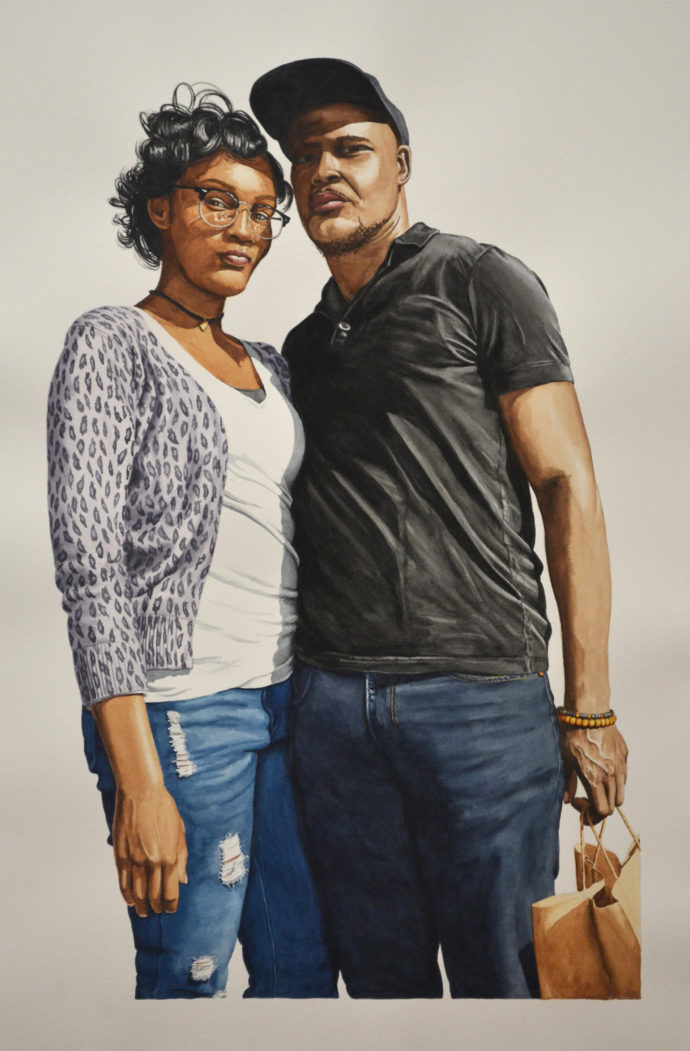
“Untitled (black couple),” watercolor, 21 Oct. 2017, image 32” x 20 1/4″
Here are the other three new paintings of the new series:
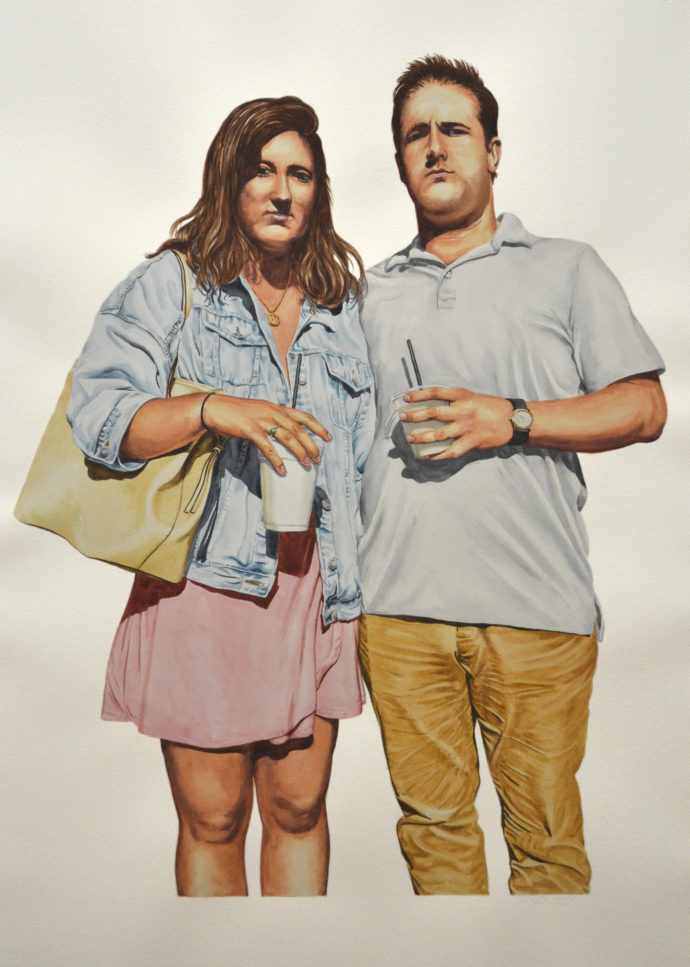
“Untitled (1st white couple),” watercolor, 5 Oct. 2017, image 30” x 23″
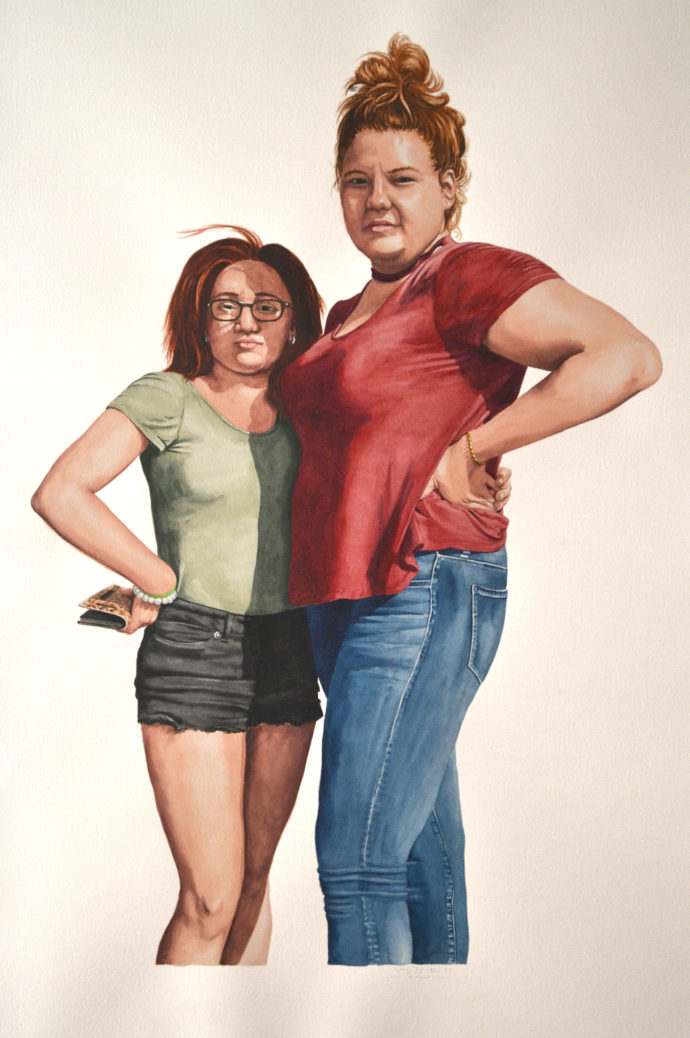
“Untitled (white women elbows),” watercolor, 3 Nov. 2017, image 32 1/2” x 21 3/4″
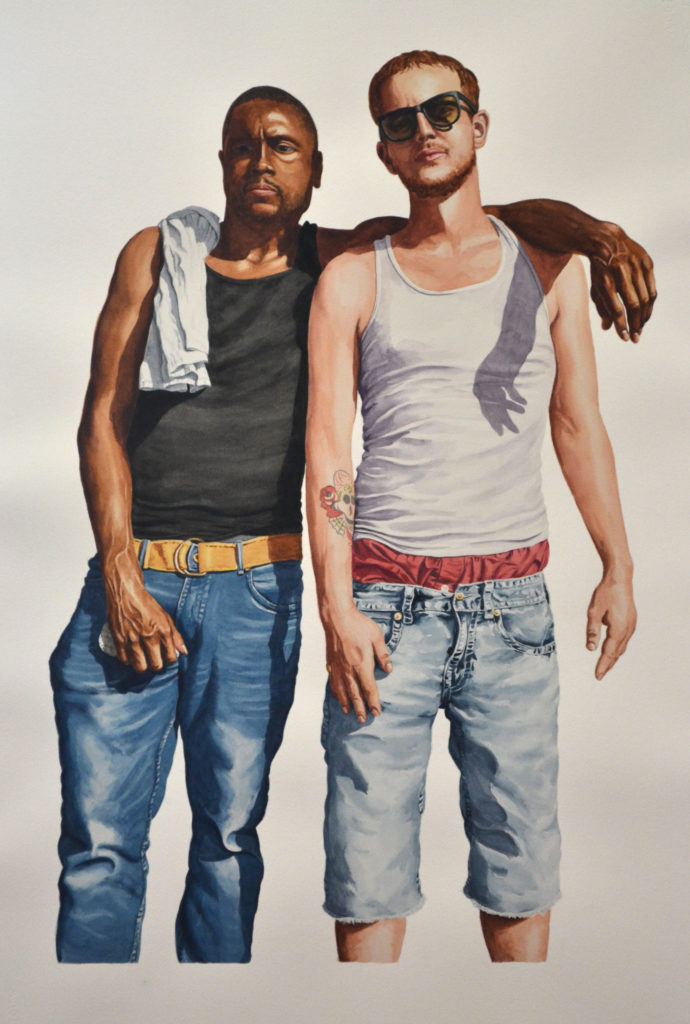
“Untitled (black guy white guy),” watercolor, 28 Nov. 2017, image 32” x 21 3/4″
Trackback URL: https://www.scottponemone.com/sidewalk-studio-deja-vu/trackback/










